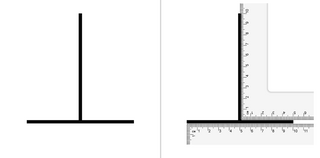Related Research Articles

Body relative directions are geometrical orientations relative to a body such as a human person's. The most common ones are: left and right; forward(s) and backward(s); up and down. They form three pairs of orthogonal axes.

Optical rotation, also known as polarization rotation or circular birefringence, is the rotation of the orientation of the plane of polarization about the optical axis of linearly polarized light as it travels through certain materials. Circular birefringence and circular dichroism are the manifestations of optical activity. Optical activity occurs only in chiral materials, those lacking microscopic mirror symmetry. Unlike other sources of birefringence which alter a beam's state of polarization, optical activity can be observed in fluids. This can include gases or solutions of chiral molecules such as sugars, molecules with helical secondary structure such as some proteins, and also chiral liquid crystals. It can also be observed in chiral solids such as certain crystals with a rotation between adjacent crystal planes or metamaterials.
Split-brain or callosal syndrome is a type of disconnection syndrome when the corpus callosum connecting the two hemispheres of the brain is severed to some degree. It is an association of symptoms produced by disruption of, or interference with, the connection between the hemispheres of the brain. The surgical operation to produce this condition involves transection of the corpus callosum, and is usually a last resort to treat refractory epilepsy. Initially, partial callosotomies are performed; if this operation does not succeed, a complete callosotomy is performed to mitigate the risk of accidental physical injury by reducing the severity and violence of epileptic seizures. Before using callosotomies, epilepsy is instead treated through pharmaceutical means. After surgery, neuropsychological assessments are often performed.

Brodmann area 9, or BA9, refers to a cytoarchitecturally defined portion of the frontal cortex in the brain of humans and other primates. It contributes to the dorsolateral and medial prefrontal cortex.

Hemispatial neglect is a neuropsychological condition in which, after damage to one hemisphere of the brain, a deficit in attention and awareness towards the side of space opposite brain damage is observed. It is defined by the inability of a person to process and perceive stimuli towards the contralesional side of the body or environment. Hemispatial neglect is very commonly contralateral to the damaged hemisphere, but instances of ipsilesional neglect have been reported.
Baddeley's model of working memory is a model of human memory proposed by Alan Baddeley and Graham Hitch in 1974, in an attempt to present a more accurate model of primary memory. Working memory splits primary memory into multiple components, rather than considering it to be a single, unified construct.

Mental rotation is the ability to rotate mental representations of two-dimensional and three-dimensional objects as it is related to the visual representation of such rotation within the human mind. There is a relationship between areas of the brain associated with perception and mental rotation. There could also be a relationship between the cognitive rate of spatial processing, general intelligence and mental rotation.

In neuroanatomy, the parieto-occipital sulcus is a deep sulcus in the cerebral cortex that marks the boundary between the cuneus and precuneus, and also between the parietal and occipital lobes. Only a small part can be seen on the lateral surface of the hemisphere, its chief part being on the medial surface.
Autotopagnosia from the Greek a and gnosis, meaning "without knowledge", topos meaning "place", and auto meaning "oneself", autotopagnosia virtually translates to the "lack of knowledge about one's own space," and is clinically described as such.
In cognitive psychology, the Eriksen flanker task is a set of response inhibition tests used to assess the ability to suppress responses that are inappropriate in a particular context. The target is flanked by non-target stimuli which correspond either to the same directional response as the target, to the opposite response, or to neither. The task is named for American psychologists Barbara. A. Eriksen & Charles W. Eriksen, who first published the task in 1974, and for the flanker stimuli that surround the target. In the tests, a directional response is assigned to a central target stimulus. Various forms of the task are used to measure information processing and selective attention.
The Edinburgh Handedness Inventory is a measurement scale used to assess the dominance of a person's right or left hand in everyday activities, sometimes referred to as laterality. The inventory can be used by an observer assessing the person, or by a person self-reporting hand use. The latter method tends to be less reliable due to a person over-attributing tasks to the dominant hand.
Extinction is a neurological disorder that impairs the ability to perceive multiple stimuli of the same type simultaneously. Extinction is usually caused by damage resulting in lesions on one side of the brain. Those who are affected by extinction have a lack of awareness in the contralesional side of space and a loss of exploratory search and other actions normally directed toward that side.

The vertical–horizontal illusion is the tendency for observers to overestimate the length of a vertical line relative to a horizontal line of the same length. This involves a bisecting component that causes the bisecting line to appear longer than the line that is bisected. People often overestimate or underestimate the length of the bisecting line relative to the bisected line of the same length. This even happens if people are aware that the lines are of the same length.
Topographical disorientation is the inability to orient oneself in one's surroundings, sometimes as a result of focal brain damage. This disability may result from the inability to make use of selective spatial information or to orient by means of specific cognitive strategies such as the ability to form a mental representation of the environment, also known as a cognitive map. It may be part of a syndrome known as visuospatial dysgnosia.
Prism adaptation is a sensory-motor adaptation that occurs after the visual field has been artificially shifted laterally or vertically. It was first introduced by Hermann von Helmholtz in late 19th-century Germany as supportive evidence for his perceptual learning theory. Since its discovery, prism adaptation has been suggested to improve spatial deficits in patients with unilateral neglect.
Visual spatial attention is a form of visual attention that involves directing attention to a location in space. Similar to its temporal counterpart visual temporal attention, these attention modules have been widely implemented in video analytics in computer vision to provide enhanced performance and human interpretable explanation of deep learning models.
Sex differences in cognition are widely studied in the current scientific literature. Biological and genetic differences in combination with environment and culture have resulted in the cognitive differences among males and females. Among biological factors, hormones such as testosterone and estrogen may play some role mediating these differences. Among differences of diverse mental and cognitive abilities, the largest or most well known are those relating to spatial abilities, social cognition and verbal skills and abilities.

Spatial ability or visuo-spatial ability is the capacity to understand, reason, and remember the visual and spatial relations among objects or space.
The meridian-crossing effect is a phenomenon described and evidenced for in the scientific field of visual neuropsychology. It refers to an increase in reaction time to non-attended stimuli located across the vertical meridian, compared to non-attended stimuli located across the horizontal meridian, i.e., the movement of attention is slower when it has to cross the vertical meridian as compared to the horizontal meridian. The horizontal meridian in a visual field extends from the left to the right of the observer. The vertical meridian, on the other hand extends from above the line of sight of the observer to below the line of sight of the observer. The vertical meridian can also be seen as a barrier that differentiates the attended stimuli from the non- attended stimuli. Meridian crossing effect can also be called different-hemifield advantage. According to this, performance rates increase when a task is completed across both the left and right visual hemifields than when performed in a within hemifield version of the task. A hemifield can be defined as a 170° range of vision that is seen by one eye focusing straight ahead. This should not be confused with bilateral distribution advantage. Different-hemifield advantage mainly holds true only for early perceptual processes. It focuses on the competition for attentional resources in spatial attention. Bilateral distribution advantage on the other hand occurs during more complex or demanding tasks. The Meridian crossing effect was first described by H. C. Huges and L. D. Zimba in the year 1987 in their paper, "Natural boundaries for the spatial spread of directed visual attention".

Mike Nicholls is an Australian researcher in experimental psychology.
References
- ↑ Bowers, Dawn; Heilman, Kenneth M. (1980). "Pseudoneglect: Effects of hemispace on a tactile line bisection task". Neuropsychologia. 18 (4–5): 491–498. doi:10.1016/0028-3932(80)90151-7. PMID 6777712. S2CID 29915370.
- ↑ Jewell, George; McCourt, Mark E. (2000). "Pseudoneglect: a review and meta-analysis of performance factors in line bisection tasks". Neuropsychologia. 38 (1): 93–110. doi:10.1016/s0028-3932(99)00045-7. PMID 10617294. S2CID 678741.
- ↑ Müller-Scheeßel, Nils; Müller, Johannes; Cheben, Ivan; Mainusch, Wiebke; Rassmann, Knut; Rabbel, Wolfgang; Corradini, Erica; Furholt, Martin (2020-01-10). Biehl, Peter F. (ed.). "A new approach to the temporal significance of house orientations in European Early Neolithic settlements". PLOS ONE. 15 (1): e0226082. Bibcode:2020PLoSO..1526082M. doi: 10.1371/journal.pone.0226082 . ISSN 1932-6203. PMC 6953813 . PMID 31923265.
- ↑ Furholt, Martin (2020). Archaeology in the Zitava Valley I. Leiden: Sidestone Press. ISBN 978-90-8890-897-2.